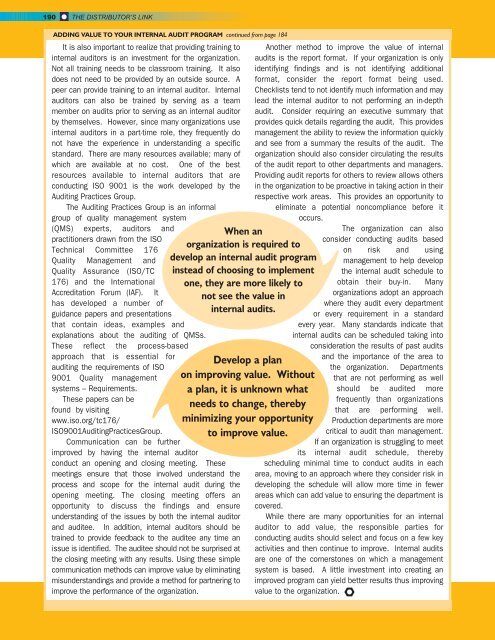SPRING 2012
Distributor's Link Magazine Spring Issue 2012 / VOL 35 / NO.2
Distributor's Link Magazine Spring Issue 2012 / VOL 35 / NO.2
You also want an ePaper? Increase the reach of your titles
YUMPU automatically turns print PDFs into web optimized ePapers that Google loves.
190 THE DISTRIBUTOR’S LINK<br />
ADDING VALUE TO YOUR INTERNAL AUDIT PROGRAM continued from page 184<br />
It is also important to realize that providing training to<br />
internal auditors is an investment for the organization.<br />
Not all training needs to be classroom training. It also<br />
does not need to be provided by an outside source. A<br />
peer can provide training to an internal auditor. Internal<br />
auditors can also be trained by serving as a team<br />
member on audits prior to serving as an internal auditor<br />
by themselves. However, since many organizations use<br />
internal auditors in a part-time role, they frequently do<br />
not have the experience in understanding a specific<br />
standard. There are many resources available; many of<br />
which are available at no cost. One of the best<br />
resources available to internal auditors that are<br />
conducting ISO 9001 is the work developed by the<br />
Auditing Practices Group.<br />
The Auditing Practices Group is an informal<br />
group of quality management system<br />
(QMS) experts, auditors and<br />
practitioners drawn from the ISO<br />
Technical Committee 176<br />
Quality Management and<br />
Quality Assurance (ISO/TC<br />
176) and the International<br />
Accreditation Forum (IAF). It<br />
has developed a number of<br />
guidance papers and presentations<br />
that contain ideas, examples and<br />
explanations about the auditing of QMSs.<br />
These reflect the process-based<br />
approach that is essential for<br />
auditing the requirements of ISO<br />
9001 Quality management<br />
systems – Requirements.<br />
These papers can be<br />
found by visiting<br />
www.iso.org/tc176/<br />
ISO9001AuditingPracticesGroup.<br />
Communication can be further<br />
improved by having the internal auditor<br />
conduct an opening and closing meeting. These<br />
meetings ensure that those involved understand the<br />
process and scope for the internal audit during the<br />
opening meeting. The closing meeting offers an<br />
opportunity to discuss the findings and ensure<br />
understanding of the issues by both the internal auditor<br />
and auditee. In addition, internal auditors should be<br />
trained to provide feedback to the auditee any time an<br />
issue is identified. The auditee should not be surprised at<br />
the closing meeting with any results. Using these simple<br />
communication methods can improve value by eliminating<br />
misunderstandings and provide a method for partnering to<br />
improve the performance of the organization.<br />
When an<br />
organization is required to<br />
develop an internal audit program<br />
instead of choosing to implement<br />
one, they are more likely to<br />
not see the value in<br />
internal audits.<br />
Develop a plan<br />
on improving value. Without<br />
a plan, it is unknown what<br />
needs to change, thereby<br />
minimizing your opportunity<br />
to improve value.<br />
Another method to improve the value of internal<br />
audits is the report format. If your organization is only<br />
identifying findings and is not identifying additional<br />
format, consider the report format being used.<br />
Checklists tend to not identify much information and may<br />
lead the internal auditor to not performing an in-depth<br />
audit. Consider requiring an executive summary that<br />
provides quick details regarding the audit. This provides<br />
management the ability to review the information quickly<br />
and see from a summary the results of the audit. The<br />
organization should also consider circulating the results<br />
of the audit report to other departments and managers.<br />
Providing audit reports for others to review allows others<br />
in the organization to be proactive in taking action in their<br />
respective work areas. This provides an opportunity to<br />
eliminate a potential noncompliance before it<br />
occurs.<br />
The organization can also<br />
consider conducting audits based<br />
on risk and using<br />
management to help develop<br />
the internal audit schedule to<br />
obtain their buy-in. Many<br />
organizations adopt an approach<br />
where they audit every department<br />
or every requirement in a standard<br />
every year. Many standards indicate that<br />
internal audits can be scheduled taking into<br />
consideration the results of past audits<br />
and the importance of the area to<br />
the organization. Departments<br />
that are not performing as well<br />
should be audited more<br />
frequently than organizations<br />
that are performing well.<br />
Production departments are more<br />
critical to audit than management.<br />
If an organization is struggling to meet<br />
its internal audit schedule, thereby<br />
scheduling minimal time to conduct audits in each<br />
area, moving to an approach where they consider risk in<br />
developing the schedule will allow more time in fewer<br />
areas which can add value to ensuring the department is<br />
covered.<br />
While there are many opportunities for an internal<br />
auditor to add value, the responsible parties for<br />
conducting audits should select and focus on a few key<br />
activities and then continue to improve. Internal audits<br />
are one of the cornerstones on which a management<br />
system is based. A little investment into creating an<br />
improved program can yield better results thus improving<br />
value to the organization.

















